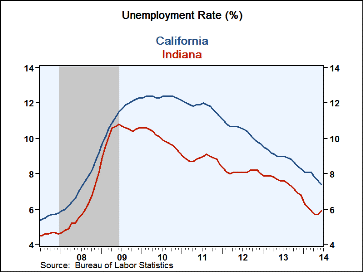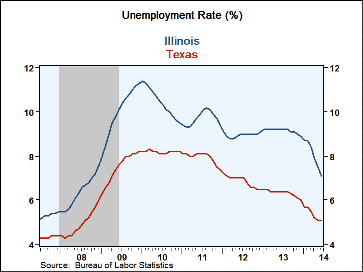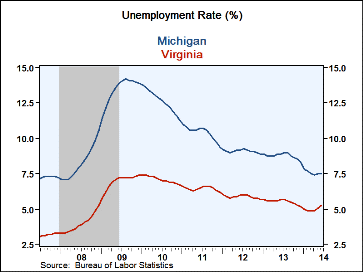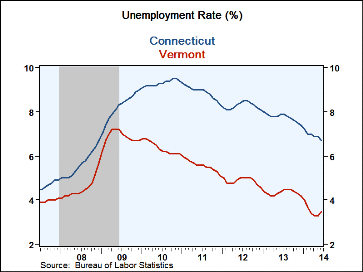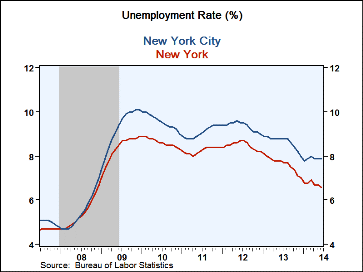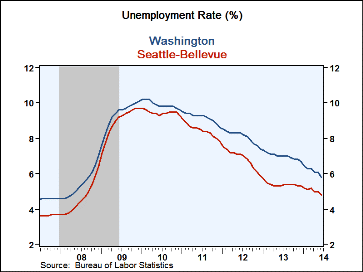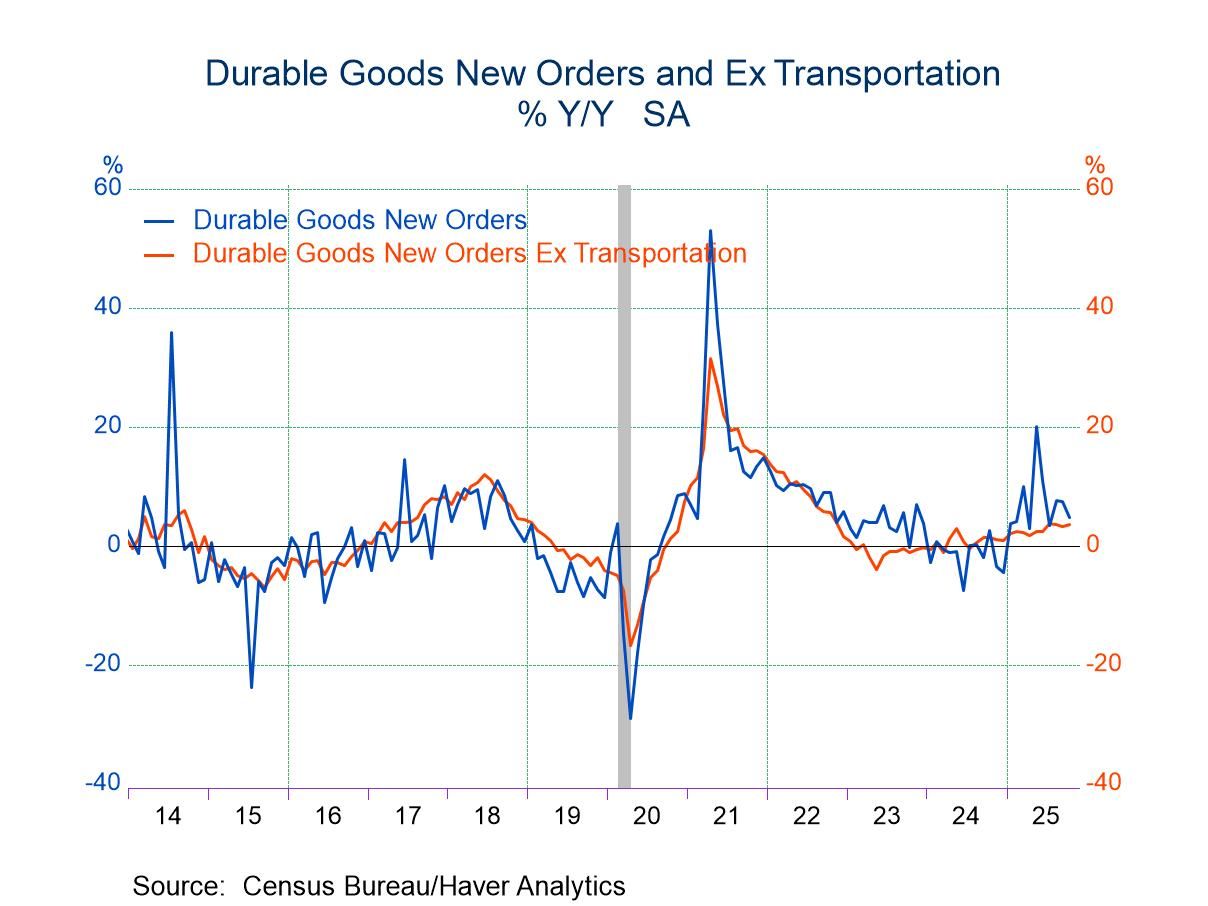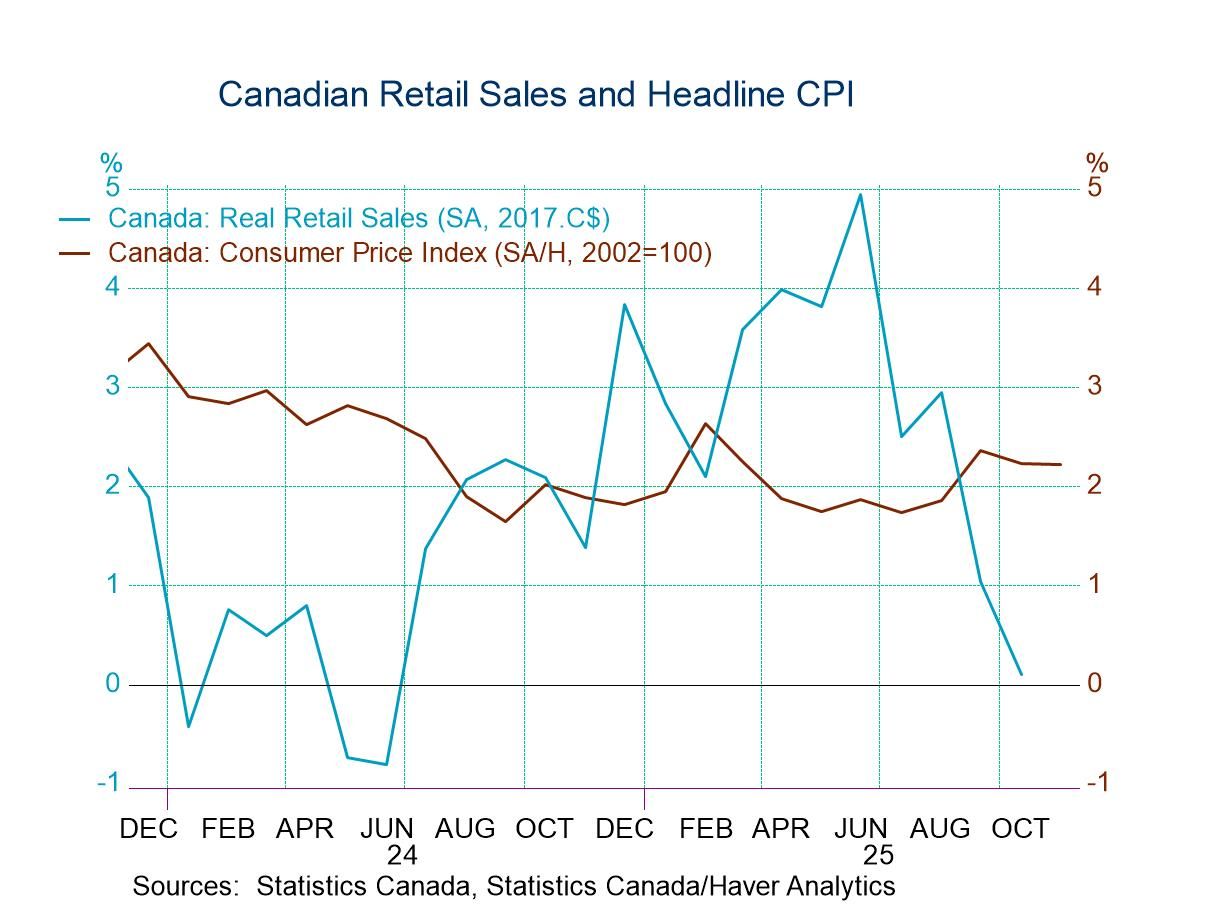 Global| Jul 18 2014
Global| Jul 18 2014U.S. State Unemployment Rates Move Lower, Some Sharply
by:Tom Moeller
|in:Economy in Brief
Summary
The overall U.S. unemployment rate fell sharply last month to 6.1%, a six-year low, from 10.0% at its late-2009 peak. There continues to be great variation amongst individual states, but a declining trend is evident most everywhere. [...]
The overall U.S. unemployment rate fell sharply last month to 6.1%, a six-year low, from 10.0% at its late-2009 peak. There continues to be great variation amongst individual states, but a declining trend is evident most everywhere. Mississippi's unemployment rate recently backed up to be the country's highest at 7.9%, but that remained below the 11.0% high reached in early-2010. Nevada's rate has gone nowhere but down to 7.7% from a high of 13.9% in 2010. The country's largest states also realized great improvement in labor market conditions. California's comparatively high 7.4% jobless rate was sharply below the 2010 high of 12.3%. Unemployment in Illinois of 7.1% remained high, but down from the peak of 11.4%. The jobless rate in Texas was down to 5.1% from its 2010 high of 8.3%. In Tennessee, last month's 6.6% rate was up a bit from the recent 6.3% low, but still compared favorably to the 2009 high of 11.0%. New York's unemployment rate of 6.6% was a recovery low and compared to the 2009 peak of 8.9%.
Amongst mid-sized states, Michigan's improvement in joblessness recently paused with the rate hovering near 7.5%. That remained, however, nearly half the 14.2% peak in 2009. Florida's 6.2% rate of joblessness has been stable in 2014 but compared favorably to 11.4% at the 2009 peak. In Virginia, the jobless rate recently backed up to 5.3% from a 4.9% low but was below the 7.4% peak reached late in 2009. Amongst smaller states, Vermont's 3.5% unemployment rate also is up off the 3.3% low but was less than half the high of 7.2% while Connecticut saw its rate move straight downward to 6.7% from a 9.5% high. North Dakota's rate at 2.7% also is little-changed during the last nine months but was down versus the 2009 high of 4.2% and Nebraska's fell to 3.7% from the 4.9% peak.
The unemployment rate figures in individual metropolitan areas continued, in most circumstances, to differ widely from the state numbers. Florida's 6.2% unemployment rate was well below the 7.2% in the Miami metro area, although Miami's rate was down from 12.4% in 2010. Michigan's 7.5% unemployment rate also was under the 8.4% jobless rate around Detroit. In 2009 it reached 16.0%. New York state's 6.6% unemployment rate stood below the 7.9% in New York City while California's 7.4% rate was under the 8.1% around Los Angeles. Also, Ohio's 5.5% rate was well below Cleveland's of 6.8%. Close to one another were the Illinois unemployment rate of 7.1% and the 6.9% rate around Chicago. Working the other way were Washington state's 5.8% jobless rate which exceeded Seattle's 4.8%.
State unemployment figures are available in Haver's EMPLR database.
| Jun | May | 2013 | 2012 | 2011 | Labor Force | |
|---|---|---|---|---|---|---|
|
Total U.S. Unemployment Rate |
6.1% | 6.3% | 7.4% | 8.1% | 8.9% | 155.7 million |
|
Ten States With Highest Jobless Rate |
||||||
| Mississippi | 7.9 | 7.7 | 8.6 | 9.2 | 10.6 | 1.3 |
| Nevada | 7.7 | 7.9 | 9.8 | 11.5 | 13.3 | 1.4 |
| Michigan | 7.5 | 7.5 | 8.8 | 9.1 | 10.4 | 4.7 |
| California | 7.4 | 7.6 | 8.9 | 10.4 | 11.8 | 18.6 |
| Illinois | 7.1 | 7.5 | 9.1 | 9.0 | 9.7 | 9.6 |
| New Jersey | 6.6 | 6.8 | 8.2 | 9.3 | 9.3 | 4.6 |
| Tennessee | 6.6 | 6.4 | 8.2 | 8.2 | 9.3 | 3.1 |
| North Carolina | 6.4 | 6.4 | 8.0 | 9.3 | 10.2 | 4.7 |
| Indiana | 5.9 | 5.7 | 7.5 | 8.1 | 8.8 | 3.2 |
| Ten States With Lowest Jobless Rate | ||||||
| Virginia | 5.3 | 5.1 | 5.5 | 5.9 | 6.5 | 4.2 million |
| Minnesota | 4.5 | 4.6 | 5.0 | 5.6 | 6.5 | 3.0 |
| New Hampshire | 4.4 | 4.4 | 5.3 | 5.5 | 5.5 | 0.7 |
| Hawaii | 4.4 | 4.4 | 4.8 | 5.7 | 6.5 | 0.7 |
| Iowa | 4.4 | 4.4 | 4.7 | 5.2 | 5.8 | 1.6 |
| Wyoming | 4.0 | 3.8 | 4.6 | 5.4 | 6.1 | 0.3 |
| Utah | 3.5 | 3.6 | 4.4 | 5.4 | 6.8 | 1.4 |
| Nebraska | 3.5 | 3.6 | 3.9 | 4.0 | 4.5 | 1.0 |
| Vermont | 3.5 | 3.3 | 4.3 | 4.9 | 5.6 | 0.4 |
| North Dakota | 2.7 | 2.6 | 2.9 | 3.0 | 3.4 | 0.4 |
| Jobless Rate In Other Selected Large States | ||||||
| Arizona | 6.9 | 6.8 | 8.0 | 8.3 | 9.4 | 3.0 million |
| Connecticut | 6.7 | 6.9 | 7.8 | 8.3 | 8.9 | 1.8 |
| New York | 6.6 | 6.7 | 7.7 | 8.5 | 8.3 | 9.6 |
| Florida | 6.2 | 6.3 | 7.2 | 8.8 | 10.3 | 9.4 |
| Washington | 5.8 | 6.1 | 7.0 | 8.1 | 9.2 | 3.5 |
| Wisconsin | 5.7 | 5.7 | 6.7 | 6.9 | 7.5 | 3.1 |
| Massachusetts | 5.5 | 5.6 | 7.1 | 6.8 | 7.3 | 3.5 |
| Ohio | 5.5 | 5.5 | 7.3 | 7.4 | 8.7 | 5.7 |
| Texas | 5.1 | 5.1 | 6.3 | 6.9 | 7.9 | 12.8 |
| Louisiana | 5.0 | 4.9 | 6.1 | 6.5 | 7.2 | 2.1 |
Tom Moeller
AuthorMore in Author Profile »Prior to joining Haver Analytics in 2000, Mr. Moeller worked as the Economist at Chancellor Capital Management from 1985 to 1999. There, he developed comprehensive economic forecasts and interpreted economic data for equity and fixed income portfolio managers. Also at Chancellor, Mr. Moeller worked as an equity analyst and was responsible for researching and rating companies in the economically sensitive automobile and housing industries for investment in Chancellor’s equity portfolio. Prior to joining Chancellor, Mr. Moeller was an Economist at Citibank from 1979 to 1984. He also analyzed pricing behavior in the metals industry for the Council on Wage and Price Stability in Washington, D.C. In 1999, Mr. Moeller received the award for most accurate forecast from the Forecasters' Club of New York. From 1990 to 1992 he was President of the New York Association for Business Economists. Mr. Moeller earned an M.B.A. in Finance from Fordham University, where he graduated in 1987. He holds a Bachelor of Arts in Economics from George Washington University.


